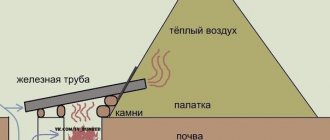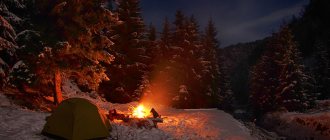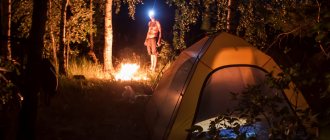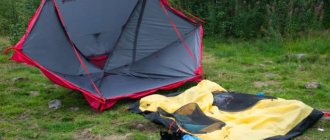Which tent to take with you to the forest for an overnight stay in winter?
Tents vary in weight, capacity and how waterproof the tent can be.
The optimal capacity of the tent is three people. Large tents are not often purchased. It is clear that in reality such a tent can comfortably fit 2 times more people. Of course, this is no longer on folding phones.
Would you like to have winter camping with two or three friends? You will need to consider the space offered by your winter tent. Test the tent in the store as each person has different needs in terms of size and space.
Most travel tents are made from tightly woven nylon or polyester fibers. Each fiber has its own advantages and disadvantages. Nylon is more abrasion resistant, but polyester absorbs less water and reacts less to ultraviolet rays.
First you must find the resistance index, which is calculated in denier. Choose a 70 denier tent if you want to camp this winter and always be safe from the weather. If your tent is not waterproofed, you can buy your plaster separately and treat your tent yourself.
When your tent sits in the rain all night, sooner or later it will get wet. In order to spend the night and live in a tent in winter, it must withstand the necessary pressure of the water column. This water resistance is designated by the letters PU and should not be less than 1500 mm. An overnight tent must have the necessary, sufficient water resistance. For example, many self-folding tents, I won’t name their brands (in a typical round case) are not very heavy, but they get wet instantly.
With a stronger structure to withstand wind squalls, snow, ice and showers, winter camping tents are heavier than summer tents but are also more stable. It has more hoops to support and stabilize its structure, which will be a prey to the elements during your winter camping sessions. Typically made of aluminum, these hoops are designed to withstand changes in cold and temperature.
Double roof or single wall tent
If you want to go outside no matter where you are, be it camping or in the mountains, you can choose between a double roof tent or a single wall tent. Those making multiple expeditions throughout the year will tend to choose a single-wall tent, which has the advantage of being lighter than one with a double roof, so easier to carry over long distances.
A tent in the forest in winter is often exposed to strong winds and frosts; when it comes to choosing a product, pay attention to the presence of a vestibule. The vestibule will protect important things from getting wet in the rain
This is a place where you store things, shoes, your backpack, hang clothes and even drive a snowmobile.
Spending the night in a tent in winter UP 2 video review
Have a transition space between the inside and outside of the tent. Many winter camping tents have a vestibule that provides ample space for storing your backpack and preparing food. There are also poles designed to make your winter camping experience easier. With these two technologies, you can set up your tent in less than 5 minutes without freezing your fingers.
Tested by the most fearless professional adventurers, they can accompany you to the end of the world and to the highest heights. Now you're ready to spend time outdoors in the comfort of your winter tent! Winter isn't always the best time for hiking - because in some areas the weather isn't necessarily very accommodating for outdoor walks.
Well, we seem to have sorted out the tents. They also take rugs with them, everything is not important here. By the way, instead of a rug, rolled foil insulation such as penotherm is perfect. In general, they are all the same, their properties do not differ significantly.
For some people, winter or non-winter, it doesn't change much. For others, winter announces the end of the season and a break of several months. For others, winter is an opportunity to enjoy the snow and make beautiful snowshoes. No matter which category you fall into, you probably suspect that hiking in the winter is a little more dangerous than in the summer.
Of course, hiking in winter will not include the same things depending on regions, countries and territories. In some places the conditions are, for example, much more wintery in the summer than in other places in the winter. In the mountains, some summer hiking routes are impossible to do in winter due to snow or are practiced in the form of mountaineering races.
Having dealt with the necessary tourist equipment, “we move on.” Let's move on to the necessary knowledge.
Necessary equipment for spending the night in tents in the forest in winter
The time when people go to the forest to spend the night is no longer something wild. Spending the night in the forest in winter in a tent in the snow also implies the presence of certain theoretical skills that have been applied in practice more than once. Many fishermen and hunters know that experience will help you stay warm.
To spend the night in a tent in the winter in the forest, in the snow, you will need a certain amount of equipment. In general, camping in a forest in winter can be classified as an extreme form of tourism. The main thing is a sleeping bag, a rug and of course a tent.
Initially I would like to debunk a certain myth. There are no insulated tents themselves. In general, the fabric initially breathes poorly, as a result of which tents are often made of two layers. Today, modern tents are most often made of very thin materials, the main purpose of which is to keep water out.
One of the main tasks is how to keep warm in a tent in winter and protect yourself from water. Warm floors are often used for this; we have already written about this earlier.
The second task is to protect yourself from the winds, as a result of which it always seems as if it is always warmer in tents.
There is a category of people who heat the air inside a tent with a gas burner. Judging objectively, this is not only very dangerous, but relatively useless, since the air cools quickly, but you don’t want to set your own portable house on fire by carelessly dropping a burner on your sleeping bag.
Let's move on to the pressing questions of many tourists - this is a sleeping bag. If you are not going to heat your tent, then for sleeping in tents in winter you need a three-layer sleeping bag. You can find out whether your sleeping bag is two- or three-layer only from the seller. There is still a difference, it will be a little colder and more uncomfortable. The shape of the sleeping bag resembles a blanket that can be unfastened to the end; it is very good if it has a headrest. This envelope is an almost insurmountable barrier to the cold.
What to pay attention to when outfitting
Experienced tourists and group instructors understand that mountain climbing, like skiing, involves spending the night in the snow. When tents are set up in not very comfortable conditions. The raftsmen do the same when they go on their first spring rafting trips, when the snow is falling on their heads and there are still snowdrifts along the banks of the river. Let's talk in more detail about what should be taken into account.
Choosing a sleeping bag
It is clear that for hikers, night sleep is a categorical requirement of survival. Whether it’s -5-6 degrees below zero or -25-30, people need to get enough sleep. So that the passage of the route does not become “universal torment.” Therefore, no summer sleeping bags! Only winter ones (three-layer), only a sleeping bag-blanket with a good zipper and headrest.
Insulated tent or tourist tent
As such, there are no insulated tents for tourist purposes. Except for a military-style tent with the ability to place a small stove-stove inside. Here, in principle, there’s no need to explain anything special: if you lit the stove, it’s warm in the tent, you didn’t have time to throw in some firewood, and it’ll cool down instantly even in calm weather.
Overnight in a heated tent (small stove)
If we take into account that tourists try to make their backpacks as light as possible due to the equipment, then the tents become thin to minimize the formation of condensation on the inner walls and all the unpleasant consequences thereof. Wind protection is the main purpose of a tent in winter. And this will be provided by ordinary tents of the “comfort” or “comfort+” type. They are quite suitable for frosty nights down to -10 degrees. It is enough to dig a hole in the snow slightly larger than the bottom of the tent, cover it with film, break and lay soft fir spruce branches - and that’s it, you can pitch the tent. If you are really afraid of freezing, then you can lay a low mound of snow on the outside of the bottom. It will reduce heat transfer, but this must be done without excesses. At most, this is a mound the height of the sides of the bottom so that the tent remains breathable. Good tents have a so-called snow skirt. It allows the shade to fit tightly to the snow. And you can add additional snow to the skirt itself.
What you definitely shouldn't do:
- cover the walls of the tent with snow high up - again, condensation! The higher the snow level outside, the more water (read condensation) there will be inside;
- cover the tent with film - the same condensation will prevent you from sleeping;
- pile spruce branches on top of the tent canvas - the walls will sag, there will be less air, and there may be breathing problems;
- pitch a tent under coniferous trees. The snow warmed above the tent on the tree branches can fall right on your head. Also, coniferous trees can fall on frosty nights;
- trying to heat the air inside the “dwelling” with burners or a fire. This is always dangerous, since tents are not fireproof things. You can use special salt heating pads, but it is better to put them in a sleeping bag.
Foam or polyurethane foam mat (one- or two-layer)
Regarding rugs or “foams,” any will do, preferably two-layer bath mats or travel rugs. The thicker the foam, the warmer it will be for you to sleep on it. However, it will be more difficult to roll it up, and it will take up more space. Follow your desires, don’t look at others - you should sleep on the mat.
Spare sleepwear
A change of sleep clothes is required! No matter what they tell you about the weight of the backpack, no matter how much experience they share (“you can do without a spare tire, your clothes will dry out in your sleeping bag, you can sleep in it…”) - you must remember that sleep in dry clothes, thermal underwear and dry Woolen socks are more comfortable than sweaty and damp ones, and your sleep will be healthier.
Tips on what you need to know to sleep in tents in the cold in winter
So, you are sitting by the fire, realizing that it is time to go to bed. Perhaps after drinking a sip of something “warming”, having eaten beforehand, you climb into the tent. Naturally, it is cold there, since we are discussing spending the night without a stove in the winter frost.
However, with good preparation and a few safety guidelines, it is entirely possible to experience the winter safely and happily. Plus, it allows you to enjoy nature in a different way, with scenery and flowers this season and fewer people on the trails.
Tip #1: Be careful, the days are shorter in winter
The purpose of this article is not to make you a mountaineer or a polar adventurer, but rather to give you some tips for hiking in winter. This is something to consider when planning your hikes. We have less time in the day, so consider this if you don't want to end up at night.
Cover the floor of the tent completely with rugs, then the cold will not penetrate from the floor into the scarf. More precisely, there will be cold, but it will not be felt so acutely. It is likely that two rugs will not be enough for the floor area. When there is nothing to cover the floor, take things and clothes out of the bag and lay them out in an even layer over the entire diameter of the tent. This will cover the uncovered areas of the floor. This will protect you from the wind blowing under the awning. In this way, you can transform the tent by making it warmer and more comfortable.
Tip #2: Clothes Management
In the summer it's easy to plan a good supply before the night. For example: for goals planned at 16, he leaves 5-6 hours. This is not a scoop, the temperature is colder in winter. In addition, the sun is not so intense that it is not as high in the sky in the summer, and temperatures can drop quickly as darkness falls.
So be sure to cover yourself and carry enough clothing with you, especially if you have no experience trekking in the cold. Always think about safety margin. Don't forget the usefulness of it in this case. The blog already has a lot of resources about clothing. Don't forget that the three-layer system can fit anywhere other than the upper body. For the bottom this could be, for example, synthetic tights, fleece trousers and waterproof and breathable trousers. In extreme cold, you can also multiply a second layer, but be careful not to be too compressed in your clothing, in which case you may feel cold.
There is a golden rule in winter - you can’t spend the night alone in a tent, not much else. Another tourist tradition says that the men are on the edge, the girl is given a place in the middle. Most often, people discuss in advance who will spend the night where and with whom. When three people sleep in a tent (gender does not matter here), all three are relatively warm.
Cloth
Change as many clothes as possible. What you've been wearing all day will most likely be a little damp and you'll be cold to sleep. If you are unable to change clothes, try heating and drying your clothes by the fire. An excellent solution would be a set of thermal underwear; it not only warms, but also removes moisture from the skin.
Don’t put on all your existing clothes at once; you risk sweating and freezing all night. It’s better to dress lighter first, and prepare additional things and put them on the side. If you get cold, you can quickly put them on.
Snow hut
50 cm and 50-90 cm long. These snow “bricks” must be strong enough to support their own weight when carried and laid on edge.
It is recommended to build the hut on a flat snowdrift at least 1 m deep. Using 2 ski poles tied to the ends of the twine, a circle is drawn in the snow. The diameter of the circle depends on the number of inhabitants of the future hut and is determined in each specific case by simple calculations. The first block is laid on its edge, slightly trimming its inner edge with a knife so that the block tilts inwards (if a large snow hut is being built, the angle of inclination should be small; for a small hut a rather significant inclination is required).
The remaining blocks are placed next to the first block, close to one another, along the line of the circle. Once the first tier is laid, the second can be started in several ways.
The simplest of them is to make a diagonal cut from the top edge of one of the blocks of the first tier to the bottom edge of the same one. blocks or a second or third block of snow (Fig. construction of hut a1)
The first block of the second tier is placed in the resulting recess so that its end is adjacent to the block of the lower tier. Then, close to the first block of the second tier, the second block of the same tier is laid, etc., continuing the construction as if in a spiral. The blocks of each subsequent tier should be inclined inward at a large angle, i.e., a more or less regular dome should be obtained. When the dome is ready, a tunnel is dug through the snowdrift leading to the hut and ending with a kind of hatch in the floor of the latter. With this design of the entrance, the warm air accumulating in the hut (people's breath, primus stove) does not allow cold air from the tunnel hatch to penetrate inside the hut (Fig. construction of hut-d).
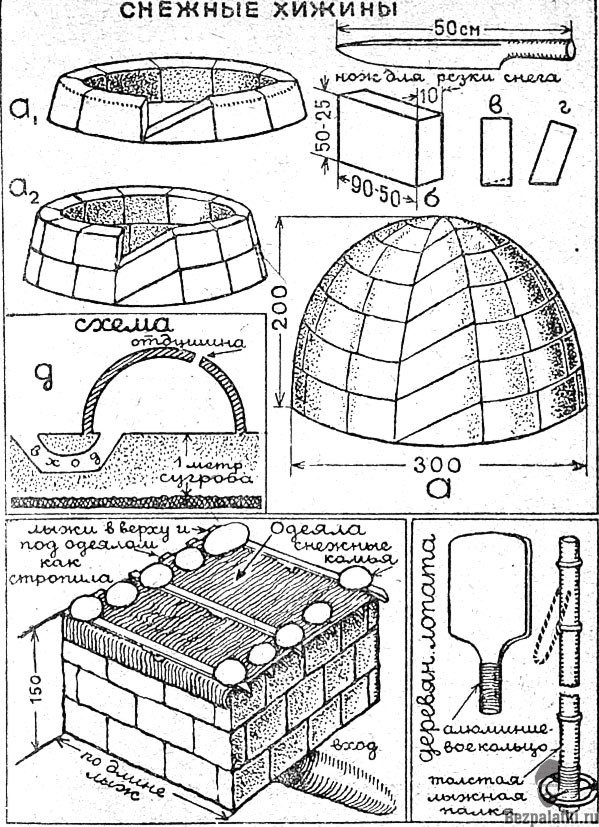
Drawing "building a hut"
I think that building a hut in the middle zone is very labor-intensive.
If a snow hut is being built by 4 people, then usually one cuts out the blocks, the 2nd carries and serves them, the 3rd builds the hut from the inside, and the 4th follows the builder outside and fills the gaps left between the blocks with snow.
After building the hut, it is recommended to light a primus stove inside, heat the air to +20-21° and, having made a hole in the dome, freeze the hut for several minutes. After such an operation, the walls of the hut inside are covered with a shiny crust of ice, as a result of which, in case of accidental contact with the walls, snow does not fall onto the floor of the hut. The hole in the dome is sealed with snow (only a small hole is left for ventilation).
Villamur Stefanson and his two comrades built their first hut within 3 hours. After some training to build a snow hut for 3-4 people. (hut diameter 3 m, height 2 m) took 45 minutes.
In a snow hut you can sleep in a sleeping bag without waking up from the cold when the outside temperature is very low. If you light a primus or fat lamp inside the igloo, it becomes very warm here, and you can sleep covered only with a blanket. Such a hut is indispensable when setting up a long-term bivouac (especially in treeless areas and in the mountains). If during a winter hike it is planned to build a snow hut at each bivouac, then the group should practice building it long before the hike.
You can make a snow hut of a simple design, but it will be colder than an igloo. Snow “bricks” for this hut are prepared in the same way as for the “igloo”; then they are made into a square-shaped structure, which is covered on top with a piece of tarpaulin or blankets (see building a hut). You can also put skis on top and pile snow bricks on them. All cracks between the blocks are sealed with snow. It is warmer to sleep in such a hut than in a tent.
When spending the night in the snow, it is always very important to thoroughly dry your equipment (socks, ski suit, boots) before going to bed. At night, boots should be taken off and hidden in a sleeping bag, and warm (fur) sleeping socks should be put on your feet, which every member of the group should have on a long ski trip in winter
If you have to spend the night without sleeping bags and you can’t make a fire due to lack of fuel, you need to build a snow hut or dig a snow hole, cave, etc., take off your frozen boots, put on dry woolen socks or fur socks and put your feet in a backpack. You can't sleep in this position.
To set up a winter bivouac you should have a snow shovel
DIY tent
In the absence of the necessary material resources, you can make a tent yourself. For the base of the tent, a regular fishing box, which can be purchased at the store, is suitable. You will also need:
- two pairs of children's skis: one is the smallest, the other is 160 cm;
- ski pole tubes;
- cot;
- tarpaulin.
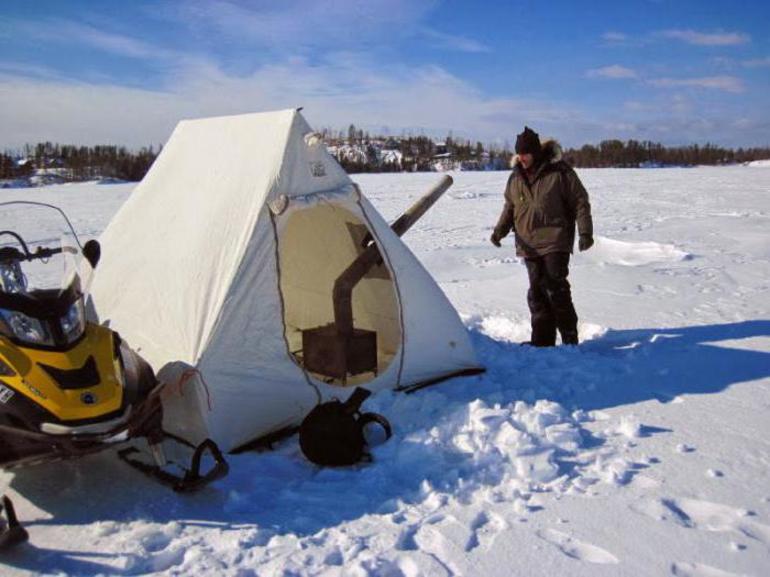
At first glance, such a device seems not entirely clear, but it is very effective and convenient to use. The result is a box that can be transported on skis and a lightweight design for a small tent that can also be moved across the ice using skis. The only negative of the resulting product is its small size, but the size of the frame can always be adjusted. A tent frame is made from aluminum tubes from ski poles.
The upper nodes, which should connect the ribs of the tent, are equipped with cylinders whose thickness matches the diameter of the tubes. The bottom of the vertical tubes is attached to the skis. The frame of the tent is connected to the box using two tubes from the folding bed and round eyes. Now all that remains is to pull up the awning. To do this, metal plates are installed on the lower edge of the fabric, through the holes of which staples are passed.
https://youtube.com/watch?v=mkyYXXrFfDI
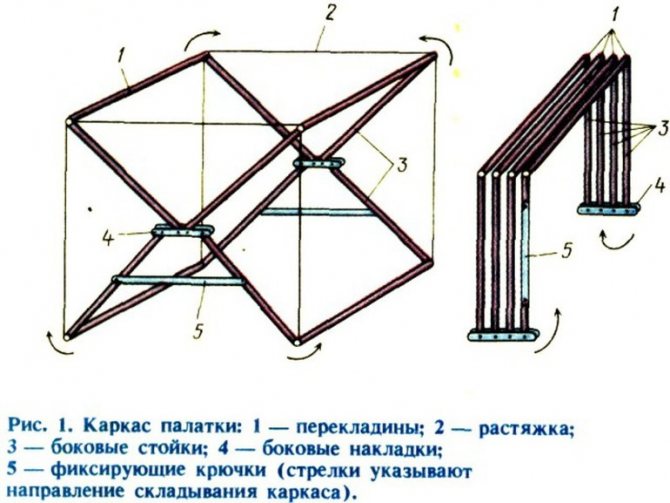
Purpose and types
All models of winter fishing tents differ from each other in size and appearance. Products are available in single, double and triple sizes. A fishing tent is specialized equipment for winter fishing, which differs from tourist equipment:
- Required height for fishing in a sitting position on a fishing box.
- Special loops designed for fastening on ice.
- Drop-down floor for fishing from holes.
- Availability of thermal insulation.
Winter fishing tents differ in the geometry of the frame, that is, in shape: cube, umbrella, machine gun, carp. The “cube” winter tent is distinguished by its outwardly convex walls, which makes the interior space larger. The advantage of this model is the high ceiling, allowing a person to stand up to his full height. The design unfolds and assembles automatically, and when folded it is convenient for transportation.
The canvas is treated with a special fireproof impregnation, which makes it possible to provide lighting and install a stove inside. The product has some disadvantages:
- poor resistance to strong winds due to the height of the walls;
- a small doorway, making it difficult for a clothed fisherman to get inside.

The winter umbrella tent has the shape of a tent. It is called so because of its resemblance to an umbrella. The main advantage is quick disassembly and assembly. The frame is made of aluminum, so the product is light in weight. The top of the tent is canvas, and the walls are made of Oxford fabric, which allows air to pass through well. The design is more reliable than the “cube”. And although the height is relatively small, a large company can fit in a four-seater.
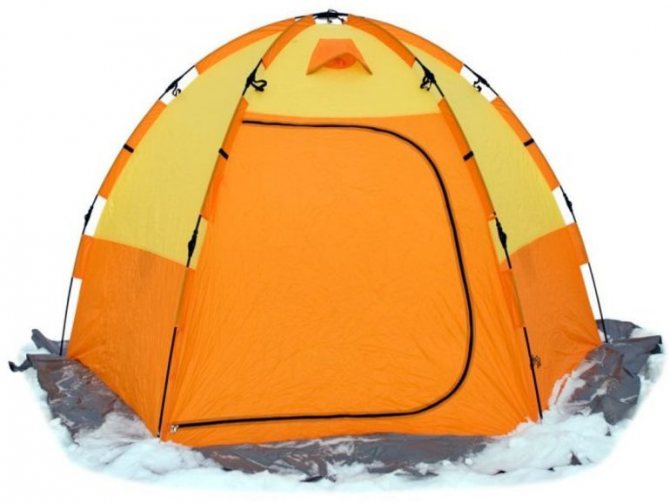
The “carp” tent is reliable and highly stable. This type of equipment is suitable for long-term fishing and is intended for one or two people. There are all conditions for an overnight stay and good resistance to weather changes. It has a rigid frame. The dense fabric of the walls can withstand a water column of up to 3 m. The model contains natural ventilation and a mosquito net. Rough weather options are available with a detachable bottom.
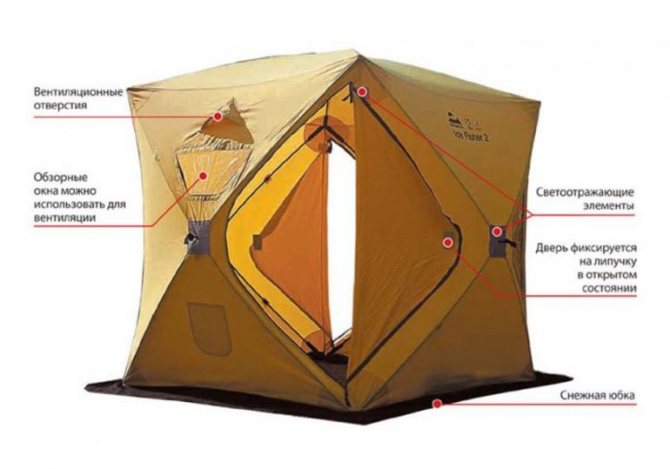
Insulation methods and materials for insulation
The tent must be insulated all around - inside and out. Materials are available and do not require large expenses. Now there are winter versions of tents on the market, but if you already have one, why buy a new one if you can insulate it yourself.
Insulating the top of the tent
The tent is insulated on top to provide additional protection from precipitation and wind. The easiest way is to use plastic film. It should be tight. The tent is covered with material and secured using office clips. From below you need to press down the polyethylene with snow or pieces of ice. Film shelter makes the tent 3-4 times warmer.
The second popular material is the fabric of an old Soviet tent. It is breathable and dense. It’s better to make a cover out of it and put it on top of the dome. Tarpaulin or Oxford protects well from the wind. With such insulation, the tent will not blow out and it will not get wet. Both of these methods increase the thermal insulation properties of the shelter by 4-6 times.
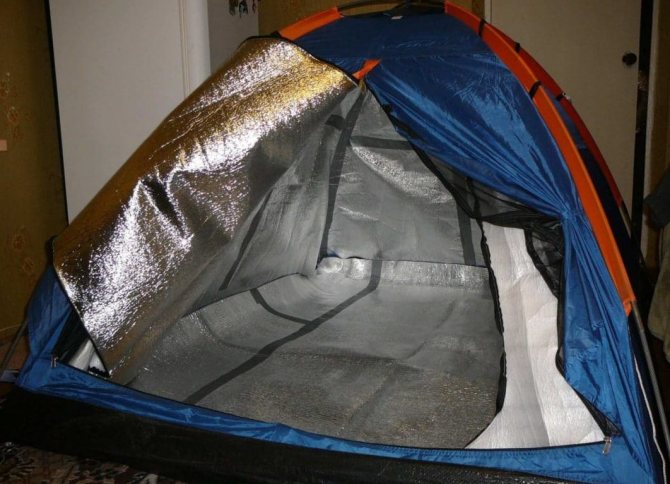
Film cover makes the tent 3-4 times warmer
It is not difficult to insulate using an awning, the main thing is that it covers a single-layer tent by at least 70%. It is preferable to make a cover that simply fits onto the structure.
Internal insulation
Insulating a winter tent from the inside is essential for harsh climates. This prevents condensation from accumulating and turning into ice. You can purchase special material or make a coating to insulate your tent yourself.
The simplest method is to insulate the walls with an old blanket. This option will not be enough for a long time, but for a slight frost, together with external insulation, it is quite enough.
A budget-friendly way is to take padding polyester or batting and staple foil onto it. You need to quilt the material in this way as often as possible so that the foil fits securely to the base. The result is a fabric with heat-reflecting properties. It is fixed to the frame using office clips. The foil layer should be positioned facing the inside of the tent so that the heat from the person and the heater does not escape anywhere.
To achieve maximum insulating effect in winter, it is better to take a ready-made specialized material - Izolon. The minimum thickness is 2mm. It is plastic, durable, and does not rot, which guarantees its reusable use as winter tent insulation. The material is made of foamed polymer with a foil coating. An analogue is Penofol, which also has reflective properties. They have one drawback - the high price.
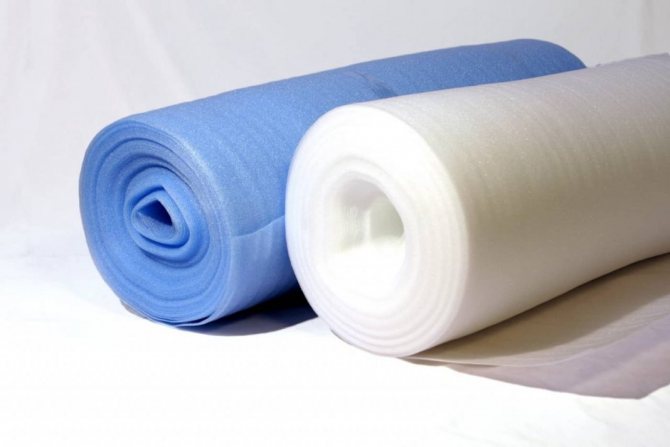
Isolon - the inner insulation of a tent
Internal insulation of the tent will allow you to retain 6-8 times more heat.
The choice of material depends on the planned time of winter fishing. If it is planned for several days, then you need to buy professional thermal insulation.
Floor insulation
Thermal insulation for the tent floor can be selected from the following materials: camping mats, insulation or thick felt. They are easy to transport in a car when rolled up. The insulation is simply laid in one or several layers. Rugs and isolon are based on foamed polymer, which holds heat well. Felt warms due to wool.
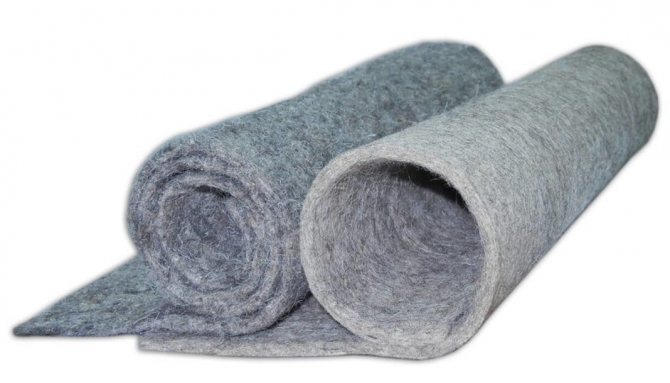
You can insulate the floor with thick felt
It is necessary to take into account that from prolonged use the snow and ice under the heat insulator will melt and a puddle will form. Therefore, the bottom layer needs to be polyethylene.
Insulating the bottom of the tent
Unfortunately, it is not always possible to purchase a tent with an inflatable bottom that protects from the cold of the ground and snow. This means you need to make a warm tent with your own hands. This can be done in different ways.
First of all, it is advisable to cover the entire bottom area. Do you have extra clothes left that you won't be wearing any time soon? It should be spread along the bottom, covering the area not covered with mats. This is very important, as it can significantly reduce heat loss. You can also put your clothes under yourself - on top of the mattresses. Of course, there is a risk that they will go astray at night and cause unnecessary discomfort. But it will be much warmer to sleep.
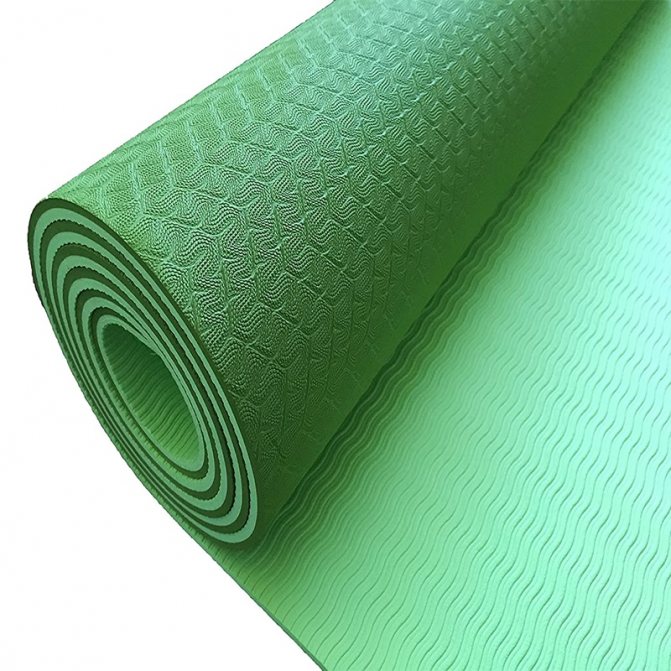
Another proven method is to use two mats, preferably quite thick ones. Still, if you have to sleep on frozen ground at -20 degrees and below, then one summer rug will probably freeze and will not perform its function. This definitely won't happen with two. Fortunately, although the foam is quite large in size, it weighs a little, which means that the backpack will not become much heavier.
Another good solution would be to buy an inflatable mat designed for cold weather. It will cope perfectly with the function of thermal insulation. By the way, if the mat is already thick, then you can put excess clothes in a sleeping bag with you - additional thermal insulation. The main thing is that after this, do not forget to ventilate it to get rid of excess moisture.
The nuances of forced heating
When the tent is insulated from the outside and inside, you need to think about heating. Device options:
- Alcohol burner. It is light and economical, but produces little heat.
- Paraffin candle. It will help in a small one-person tent in mild frost. The flame is directed upward, and all the heat is concentrated there. For normal heating you will need 10 candles. The downside is the high fire hazard. You will have to watch the candles all the time so that they do not fall and set the tent on fire.
- Dry fuel. There are so-called “dry alcohol tablets”. They can be used, but you will have to be distracted every 15 minutes to ignite a new tablet. The advantages are the absence of odor and soot.
- Gas lamp. Recharges with propane. It provides little heat and is only suitable for mild frosts.
- Gas heater. There are many different modifications. The simplest is “Pathfinder” with a power of up to 2 kW and a flow rate of up to 110 g/h. Weighs only 370 grams and can heat a room up to 20 sq.m.
- Gas burner with infrared radiation. Connects to a gas cylinder with a capacity of 5-50 liters. Power from 1.45 kW, consumption from 100 g/h. You can cook food on this device.
- Catalytic heating pad for individual heating. Placed on clothing. Portable device charged with highly purified gasoline. Safe device with a minimum flow rate of 20 ml/hour. Battery life -16 hours.
- Gas infrared heater "Solyarogaz". Budget device with good power. Quickly heats up a small tent space.
- Gasoline Primus tourist. Allows you to cook food and heat water, while warming the tent. Not suitable for heating separately.
- Mini solid fuel stove. Runs on coal or wood. The pipe must be routed outside the tent. Use for short-term winter fishing is not justified. You need to take fuel with you and build an outlet for the pipe.
When using any type of heater, there is a mandatory condition - the tent must have a ventilation hole. Otherwise, there is a risk of poisoning from combustion products.
Gas appliances have a big disadvantage - in severe frosts the gas freezes, so the tent must be properly insulated. In addition, you need to take a gas cylinder with you.
In addition to modern ones, there are old methods that fishermen have used since ancient times:
- Hot stone. A large stone is heated over a fire, wrapped in several layers of foil and placed on a board in the tent. The heat generated will last for about 6 hours. Difficulties - you need to make a fire and look for a stone.
- Boiling water. A bucket of water is heated, closed tightly and placed on a stand. Heating will last for 4 hours. The main thing is not to forget about the dangerous object and not get burned.
Of course, improvised heaters will not be enough for the entire frosty night. For a short time, you can get by with these available means.
How to make it warmer
Winter tents are insulated with additional awnings, tarps, and heated using stoves. The stoves used are prefabricated wood or gas, powered by cylinders.
However, there are several simple tricks on how to make your stay in a camping house more comfortable in severe frost using improvised means.
The first step is to isolate the bottom as much as possible from ice or cold soil. This can be done by placing a cushion of spruce branches or dry grass or moss under the base. It would be ideal to lay a durable plastic film on top of the bedding. This will prevent melted water from reaching the bottom of the living compartment.
The next method is to set up a tent in a small recess dug in the snow to a depth of 40-50 cm. The walls of the recess are reinforced with a mesh of twigs. If possible, the snow is raked down to the ground and the site of future installation is heated with a fire.
Homemade heater
Even if the tent does not have a stove installed, you can heat it with a tablet of dry alcohol or a simple candle. To do this, it is lit in an empty metal tin can, having previously made several holes at the bottom edge for air to enter. The jar should be placed on a non-flammable stand away from the walls.
It will significantly insulate the structure outside the hut (or a simple shield on the windy side). It’s also a good idea to create an additional, second or third, layer on top of the tent from covering materials - polyethylene, construction non-woven substrates, any material. On sale you can find thermal blankets made of film covered on one side with foil. This is a good option for additional insulation.
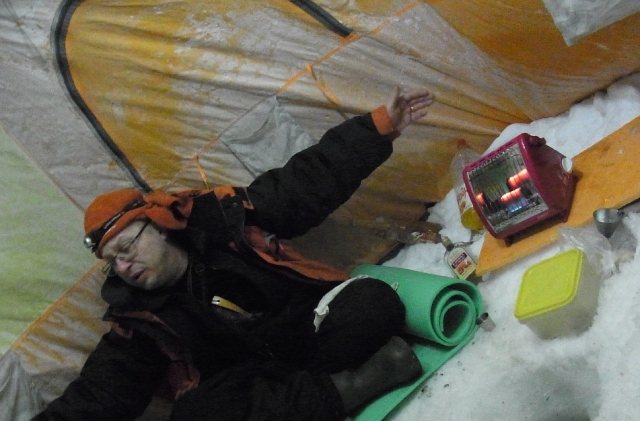
When spending the night in winter, ventilation must always be provided. Otherwise, condensation will form on the walls, which reduces the thermal insulation properties. In addition, heating without ventilation threatens the formation of high concentrations of carbon monoxide and poisoning.
How to insulate a tent
In general, if you plan to go to a place where the temperature can drop below zero Celsius, then it is better to choose an insulated tent in advance, which is made of material that allows air to pass through, otherwise condensation will form on the walls, and this will affect your well-being. And if you are traveling alone or in a small group, then it is better to choose smaller tents - these hold heat better.
- The first thing to remember before setting up camp is to determine which direction the wind is blowing from and position the tent with the entrance and all vents in the opposite direction. This way, your temporary home will be protected from gusts of cold wind, and this arrangement will make it a little more stable.
- And one more thing - arrange your overnight stay away from dry trees, otherwise the tent may catch fire when making a fire.
Well, now the insulation itself.
The most common method is heating, but it does not have a long-lasting effect. That is why the heat source must always be in working order. These include:
- Candles. Regular wax or paraffin candles are the cheapest warmer, but they can only help in warm weather.
- Gas stove. Small gas stoves are a reliable source of heat for several hours, and you can also prepare tea or hot soup on them. But for such tiles you will have to stock up on gas cylinders.
- Dry fuel. A tablet that can be placed in a regular tin can, where several holes are made with a knife. But such a heater cannot be used for a long time due to the evaporation of gases.
In order for a tent to keep warm, there are various ways to insulate it:
- Infrared film. It is quite an expensive pleasure, and besides, it requires electricity, so this option is not in wide demand among tourists. But it works like a real heater.
- Foil insulation. Foil retains heat well, so you can lay insulation on the floor of the tent and cover the walls with it, then the cold will not penetrate from the outside, and the heat from heating will last longer.
- Moss. If you have neither insulation nor any special devices, then you can make do with improvised means. Collect moss during the day (a must, since the moss is wet in the morning) and lay it in layers on the floor of the tent. Straight to the bottom. You can cover it with a blanket or carpet, but if you don’t have one, feel free to put sleeping bags and mattresses on top.
- Soviet tent. If you scratch around, then, probably, many people will find in their attic or pantry an old Soviet tent from the Soviet period. It can be used to cover the top of your tent, and the thickness of the material will provide 4-6 times insulation.
These are the basic methods of how to insulate a tent, which may be useful to you if you are planning to go camping or fishing with a group.
Warm winter tents. Myth or reality?
How to insulate a tent for outdoor recreation in low winter temperatures?
There may be many answers, but if you are using a single-layer tent that does not have a bottom, can you call it a camping home and count on it in any season? Of course, the comfort level of a winter tent is determined by a combination of factors and equipment that are available for tents from various manufacturers. Tents for winter, as a rule, have special equipment and meet a number of requirements that make it possible to use them in the cold season.
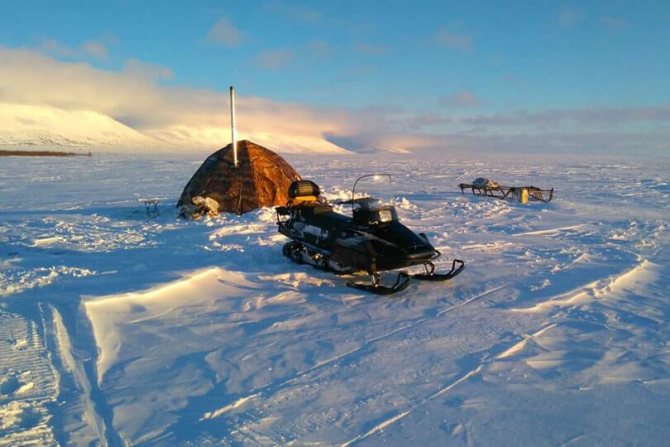
Open type shelter
1.Snow trench
Such a shelter is dug out of snow at least 1.5 meters deep. You can use skis, a bowl, or a piece of plywood as a shovel.
Very good shelter is obtained in ravines and hollows. Essentially, it’s just a slot-like hole one and a half or 2 meters deep and covered on top with fabric or polyethylene. The roof is made from tree trunks and branches or skis and sticks (if you are in a treeless area). The roof can be sprinkled with snow on top (additional thermal insulation).
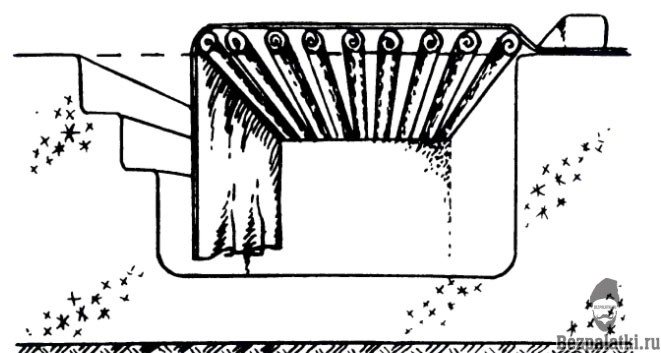
In the taiga, you can build a similar cave near the trunk of a fluffy spruce or cedar. The paws will serve as a kind of roof. Clear the area of snow around the trunk in a circle. In such an improvised hut you can even make a small fire
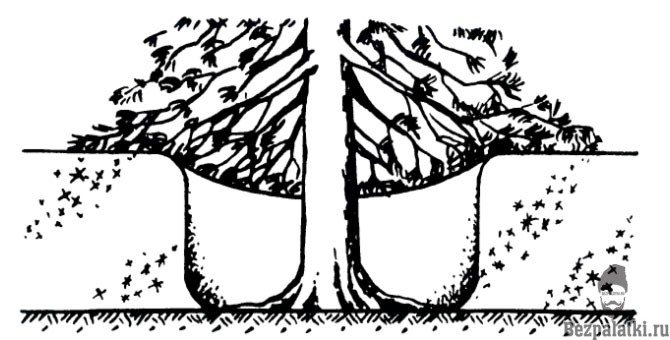
2.Snow pit
This structure is very reminiscent of a hole. As a rule, it consists of a pit tunnel and the hole itself. The minimum thickness of the ceiling should be 20-30 cm, otherwise it may collapse. If the snow is loose, then it is almost impossible to build a snow pit.
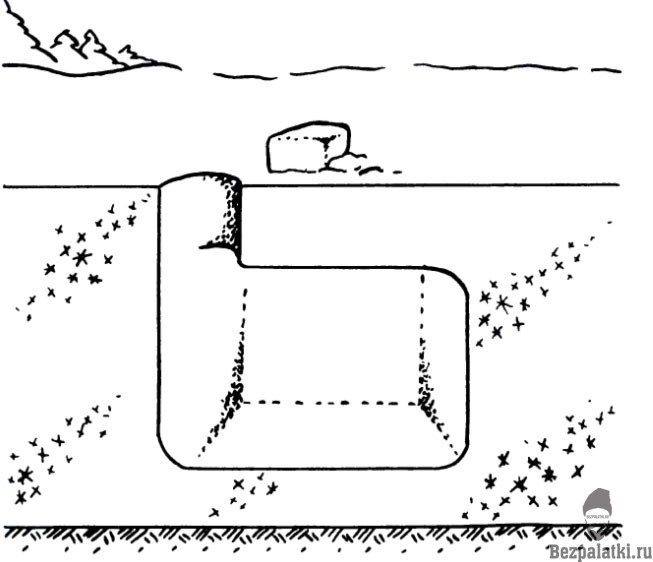
Closed shelters
1.Snow cave
A snow cave digs into the slope. Remove excess clothing so that it does not get wet, fasten all cuffs, buttons, zippers.
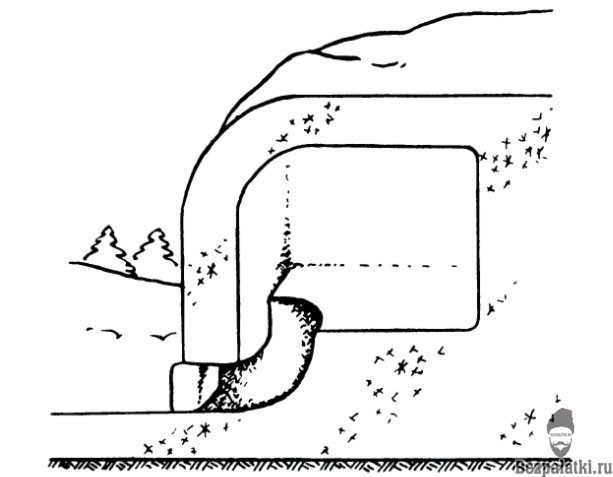
Classic snow cave
Cave construction algorithm
- First a hole is made
- A narrow tunnel is being dug
- The end of the tunnel is expanded upward to the size you need
Recommendations
- The entrance should be no more than 60 cm (so that the cold does not pass through)
- The horizontal hole should go to a depth of up to one and a half meters
- The ceiling of the cave should be vaulted
- Caves can be classic version 1 and non-classical. Non-classical caves may not have a front wall and are closed with polyethylene or snow blocks
- if you will make a fire in the cave, provide ventilation (required), this also applies to snow trenches
Non-classical snow cave type 1
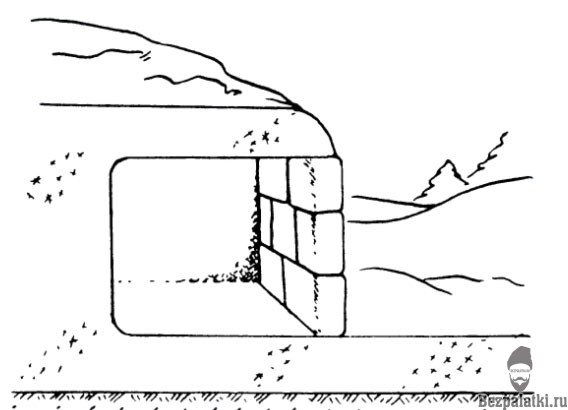
Non-classical snow cave type 2
2. Snow den
A snow den digs around windbreaks and rubble in the taiga; there are very large accumulations of snow there. A snow den is dug in the same way as a cave.
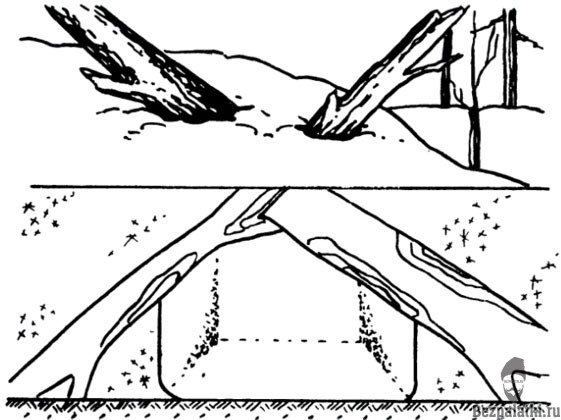
Single snow hole
In cases of extreme necessity, you can wait out the night in a single burrow of small thickness. You need to dig a hole so that the dead-end side is raised. In such a room it will be less comfortable than in an ordinary hole, but warmer than on the street. The point is that the person who spends the night in it should be above the entrance level and be in an air cushion, the bottom is lined with a layer spruce branches or sticks.
If your feet are frostbitten or you have lost your shoes, you can spend the night in such a hole with your feet inward and cover your head with plastic or wrap it in fabric.
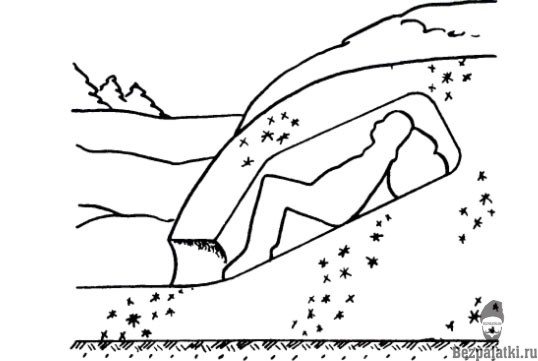
Single hole
Requirements for winter tents
Finding camping equipment begins with analyzing the conditions. Spending the night in a winter forest is different from relaxing in the mountains. Often tents for winter hikes are taken for fishing. Therefore, it should be possible to make a hole there; the moisture inside should not negatively affect the microclimate.
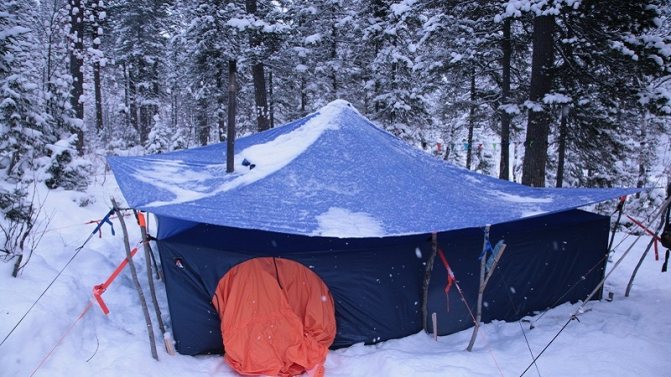
General requirements:
- resistance to gusts of wind, preservation of shape;
- temperature changes do not affect the elasticity of the material, and the likelihood of damage due to mechanical stress does not increase;
- easy installation, this is necessary if you don’t have time to fix the tent;
- light weight so that it does not take up much space in your equipment;
- good thermal insulation, if there is a heat source inside, cooling should not be rapid.
To choose, you need to take into account several factors - budget, capacity, availability of additional functions. If damaged, you can quickly make repairs by applying stickers to the hole and patching it.
The basic requirements for winter hiking tents are wind-resistant, two-layer bedding throughout the entire volume; aluminum poles are used to reduce weight. For thermal insulation, there must be a vestibule with two sealed valves in front of the entrance.
A skirt is not necessarily a requirement for winter hiking. To increase the weight, the edges can be dug up and a snow shelter can be made around the structure. Capacity – number of people plus one. You need extra space for things and other equipment.
